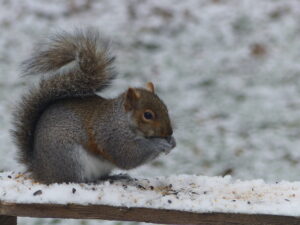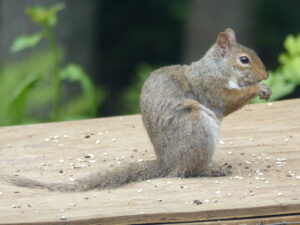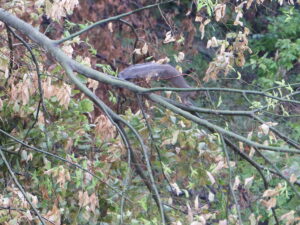The birds we share Winding Pathways with have a good life. Our property has old trees, prairies, and bushes to provide lots of natural food plus nooks and crannies for chickadees, nuthatches, and other species to hide and shelter from tough weather.

Squirrel tails have many uses.
Birds aren’t the only animals that gorge on the sunflower seeds and corn we daily put in the backyard. Deer, raccoons, and opossums sometimes visit at night. And squirrels constantly work the day shift.
Two Species
Two squirrel species visit our feeders. Grays are more of an eastern species that prefer woodlands with big trees, while Fox Squirrels prefer edges – places where woods meet prairies, cornfields, or meadows. They are most common in the Midwest.

Even in winter the squirrels’ fur looks healthy…except for their tails.
In spring 2021 through winter 2022, we have noticed that many squirrels, especially grays, had few tail hairs, making them look like rat tails. That’s not good for a squirrel.

Squirrels use tails for balance.
Their bushy tail is more than an ornament. We’ve observed three important uses. It helps them balance. Notice this when you see squirrels cross wires or balance on tiny branches bouncing in the wind. On cold and wet days, we see squirrels drape their tail over their back, perhaps like putting another blanket on the bed or a poncho. Twice we’ve seen squirrels fall from tall oaks. Both times they “spread eagle” in the air with their legs and tails outstretched. They descended with their body horizontal, hit the ground with a thump, and took off running, apparently unhurt. So, their tail helped them parachute down.
Furless Tails
According to Dr. Neil Bernstein, a squirrel lacking a tail may have been in a mating fight with another male and came out the loser. Four of our resident squirrels have a tail but each lacks hair. It could be mange, but this often leaves a bare patch of skin on the animal’s body. Our squirrels have perfect body hair.
Loss of tail hair could be caused by a fungal disease called dermatophytosis. Often this causes hairs to break off, rather than shed from the skin. A squirrel with this condition has short bristles. We think that’s the case with our squirrels.
Often otherwise healthy squirrels recover from mange or dermatophytosis. We hope ours will.


I saw a squirrel like that in our yard this winter as well & I wondered at the time what on earth had happened to it’s tail! Our dog was close on the heels of that particular squirrel as it ran for it’s life up our battle-scarred butternut. It looked so odd to me I actually went outside to get a closer look, almost wondering if it could be something other than a squirrel. While I readily agree with your three 3 observations of why squirrels need their bushy tails, I noticed one possible advantage of a nearly hairless tail that day: as my dog and I stood nearby scanning the tree for the critter, I finally spotted it, 3/4 of the way up the small old tree’s trunk, motionless, waiting for us to be gone. Without the bushy tail, it blended into the trunk with ease and my dog at least had lost sight of it.
Kim, what an interesting observation! Thank you for sharing. M~